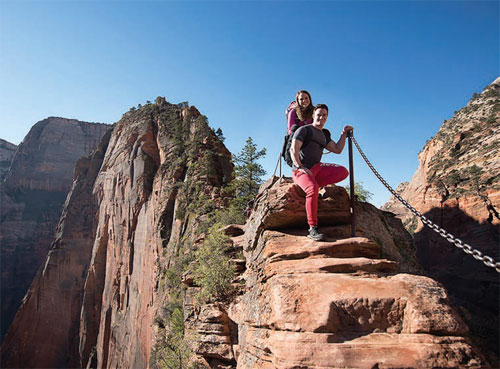It’s hard to overstate the importance of Utah’s 13 national parks, national monuments and historical areas to the state’s economy. In 2018, visitation to these areas accounted for $1.84 billion in economic benefit in Utah. Those expenditure were made by 15.37 million visitors to the state’s parks and recreation areas administered by the National Park Service (NPS), according to the “National Park Visitor Spending Effects” report released late last month by the agency.{mprestriction ids="1,3"}
Southern Utah’s Zion National Park had the most visitors among the states’ five national parks, with 4.3 million people passing through its gates. Zion visitors spent $246 million last year. Officials estimated that more than 86,000 people visited Zion over the recent Memorial Day weekend.
Glen Canyon National Recreation Area, which Utah shares with Arizona, saw 4.2 million visitors who spent a whopping $411 million on lodging, food and recreation. Bryce Canyon National Park came in third with $227 million coming from 2.7 million visitors and Arches National Park saw 1.7 million visitors spend $200 million and nearby Canyonlands National Park had $45.8 million come in through 739,000 visitors. Capitol Reef National Park had 1.2 million visitors spend $89.2 million.
Overall, Utah’s “Mighty 5” national parks contributed $808 million to the state’s economy in 2018. National Park Service officials said that visitor spending has doubled since 2012.
Utah came in fifth nationally for visitor spending behind California, Alaska, Arizona and North Carolina.
Almost 35 percent of Utah’s benefit was spent on hotels and 19 percent was spent on restaurants. Gas and transportation made up another 19 percent while retail was just under 10 percent of total visitor spending.
Other interesting facts released in the National Park Service’s report include:
• Utah has 169 miles of rivers designated as Wild and Scenic (on the Virgin and Green rivers).
• NPS manages four national trails in the state.
• The are 1,841 sites in Utah on the National Register of Historic Places.
• There are 2,535,381 objects in national park museums in Utah.
• 6,854 archeological sites lie within Utah’s national parks.
Nationally, NPS reported that visitor spending for national parks visits in 2018 resulted in a $40.1 billion benefit to the nation’s economy and supported 329,000 jobs. The report said more than 318 million visitors spent $20.2 billion in communities within 60 miles of a park in the National Park System. Of the 329,000 jobs supported by visitor spending, more than 268,000 jobs exist in the park gateway communities.
“This report emphasizes the tremendous impact the national parks have on our nation’s economy and underscores the need to fulfill Pres. Trump’s plan to rebuild park infrastructure,” said Interior Secretary David Bernhardt. “With 419 sites — and at least one in every state — our national parks continue to provide visitors, both local and destination, with innumerous recreational, inspirational and world-class experiences.”
Economic benefits from visitor spending increased by $2 billion in 2018 and total impact increased by $4.3 billion in comparison to 2017, the report said.
As a part of the report, visitor surveys were conducted at 19 parks with the results indicating that people are spending more time in the parks, staying longer in gateway communities and spending more money during their visits than in recent years.{/mprestriction}








